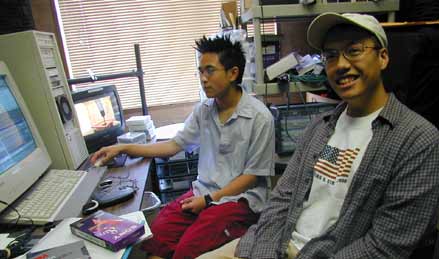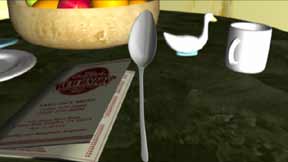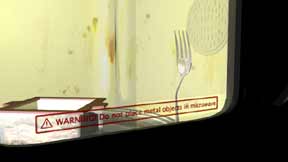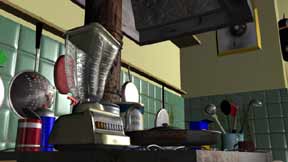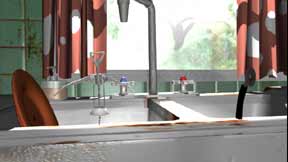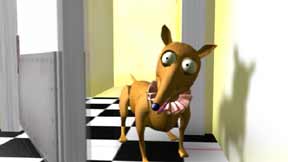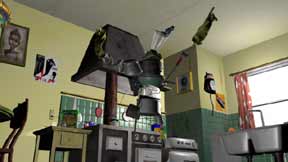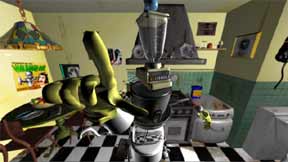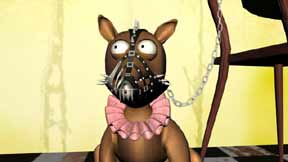Please cast your vote for "Kichen Katastrophe" to win 1st place in the Asian American Internet Film Festival
What Dreams May Come
Young animators
learn the art of computer animation
at Palos Verdes on the
Net.
By Michelle Fisher
Animate means "to give life to." Offering the latest in computer animation technology, Palos Verdes on the NET does more than supply equipment and training—it gives life to the dreams of young filmmakers like Derrick Auyoung, 19, and Andy Huang, 16, who just wrapped their first fully animated short film, "Kitchen Katastrophe."
It took the teenagers just over a year to complete the film affectionately called "KK" around the bustling computer center located in Rancho Palos Verdes. Derrick and Andy are quick to share credit with others, including their co-producer Juan Añorga and Avid ace David Wadsworth, who taught them to use the editing software that is the standard in Hollywood. About a dozen interns assisted with modeling all the characters appearing in the nine-minute film.
Derrick and Andy estimate that roughly 1,000 hours of work went into the finished product. They began work on it last summer, but once school started, they had to balance it with homework and other activities. Derrick, a UCLA student, often drove in on weekends to work with Andy, a junior at Peninsula High School."It was originally planned as our summer project, but all the animation took longer than we expected so it ended up stretching until this summer," Andy says.
"It’s like a gradual ending," adds Derrick, "because we’ve been working on it so long. When it was done, it was like, ‘Wow, we’re finished!’"
Filled with action and comedy, "Kitchen Katastrophe" tells the story of a frantic fork who must rely on his friends to rescue him from certain death in the microwave oven where he was inadvertently placed. Various utensils and appliances, including Mr. Blender and Toaster, hurry to spring him from his cell before catastrophe strikes.
Andy says they chose this subject matter because of its universal appeal. "We wanted to bring to life all the utensils and stuff," he explains. "We just wanted to see how far we could take the animation."
Although most of the animation work was executed using Maya 2.5—the software used by big special effects production companies such as DreamWorks—the young artists also created detailed drawings of the kitchen from different perspectives.
"It took a long time to model the whole kitchen," Derrick says. "We wanted to make it look convincing."
They drew many of the film’s major players, borrowing other images from a visual dictionary. They set up a makeshift Foley stage (soundstage) and recorded sound effects, using pots, pans, appliances and utensils from home. Derrick did the voices.
"Originally, there was no dialogue, but we thought it would add character," Andy says.
They also created storyboards—67 in all—which they had the opportunity to show at DreamWorks last summer during a field trip to the Glendale studio. The storyboards contain intricate drawings of individual shots as well as story notes, like one describing the spoon as "dejected with failure."
Derrick says they learned a lot while making the short sci-fi film, "Just in Time," in 1999. "This one took longer than ‘Just in Time’ because we designed everything. We put more thought into story and character design," he says.
"Art is a really big part of this," says Andy, who has been drawing since age 2. His mother, Eleanor, says his early drawings of elephants and castles alerted his parents to his gift. Later, he developed an interest in puppetry that helped him to see—and design—objects in 3-D. Eleanor says she and her husband are very proud of their son’s achievement. "We’re very excited about their new short film. Considering their age and limited experience, it’s very well done," she says.
"What we appreciate is the opportunity at PVNET for Andy to learn different software and to have the opportunity to draw what’s on his mind," she continues.
Yet Andy emphasizes that the software is only one half of the equation. The purpose of animation, he says, is to tell good stories. "Unless you have the concepts behind the work, it’s meaningless. The stories and ideas behind it are the most important part," he says. "Animation is just a tool to tell your story."
Adds Derrick, "The animation department here encourages kids to think creatively and interpret ideas visually."
"We’ve created an environment where kids with an interest in computer animation can experiment and pursue their creative ideas," says Ted Vegvari, director of PVNET.
Derrick is too modest to call himself an "animation expert," but everyone at the center agrees that he is. He does admit that he taught himself computer animation through research, online tutorials and experimentation.
"I think about it all the time—making movies. After taking an animation class, your whole way of thinking changes," Derrick explains. "You watch the way people walk to get a feel for the movement."
Andy says "Kitchen Katastrophe" was inspired by computer-animated films like "Toy Story" and other Pixar productions. Andy also cites "Wallace and Gromit" and "The Nightmare Before Christmas" as major inspirations. Derrick discovered his calling, he says, while watching the first "Jurassic Park."
Now that they’ve finished the animated short, both boys are eager to work on their own projects. Derrick has already built an animated Tyrannosaurus rex.
"It was my dream to do this. I’ve wanted to build a T. rex ever since I was 11 years old," he says, beaming at his creation. "I’ve fulfilled that dream."
The complete "Kitchen Katastrophe" crew includes: Juan Añorga, Derrick Auyoung, Kurt Burian, Alex Gold, Andy Huang, Elyse Lluncor, Diviya Loomba, Bryan Lovell, Austin Norris, Drew Ruderman, Skyler Ruderman, George Sato, Betsy Smit and Casey Wixted.
For more information about PVNET’s animation program or future screenings of "Kitchen Katastrophe," call 541-7992 or visit www.palosverdes.com/animation.
